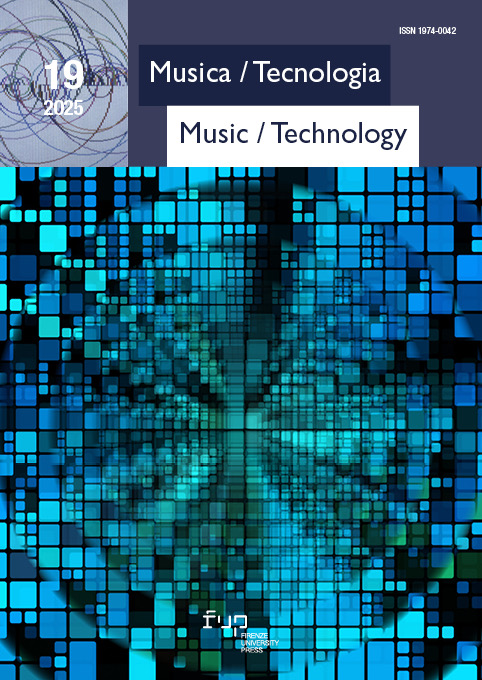Published 2025-06-10
Keywords
- feedback experimentation,
- electroacoustic instruments,
- collaborative composition
How to Cite
Copyright (c) 2025 Daniele Pozzi

This work is licensed under a Creative Commons Attribution-NonCommercial 4.0 International License.
Abstract
In my compositional practice, I view feedback as an instrument to address spaces of situated sound inquiry. Such spaces are practically intertwined with, and often mutually defining, the material space in which feedback operates. Feedback instruments as such develop at the intersection of these spaces, becoming mediators between artistic concerns and the material affordances that form and inform them. The first part of this article introduces some of these concepts – instrument, medium, material space – by contextualizing them in the current artistic research discourse, and by situating them in selected examples of historical and contemporary feedback-based productions. In the second part I make use of these ideas to illustrate some of my recent works, focusing in particular on the productive intersections between notions of instruments, media, and spaces in feedback practice.
Downloads
References
- Ahamed, Syed V. 2014. “Foundations of Knowledge.” In Next Generation Knowledge Machines, edited by Syed V. Ahamed, (pp. 171-189). Oxford: Elsevier. https://doi.org/10.1016/B978-0-12-416629-5.00007-4. DOI: https://doi.org/10.1016/B978-0-12-416629-5.00007-4
- Ahamed, Syed, V. 2017. “Real Space, Knowledge Space and Computational Space.” In Evolution of Knowledge Science, edited by Syed V. Ahamed, (pp. 431-450). Boston: Morgan Kaufmann. https://doi.org/10.1016/B978-0-12-805478-9.00027-3. DOI: https://doi.org/10.1016/B978-0-12-805478-9.00027-3
- Burns, Christopher. 2004. “Designing for Emergent Behavior: A John Cage Realization.” In International Computer Music Conference. San Francisco: International Computer Music Association.
- Collins, Nicolas. 2002. “All This and Brains Too.” Resonance Magazine 9(2): 6-7, edited by Knut Aufermann.
- Collins, Nicolas. 2021. “Improvising with Architecture. Pea Soup and Related Work with Audio Feedback.” Resonance 2(2): 168-181. https://doi.org/10.1525/res.2021.2.2.168. DOI: https://doi.org/10.1525/res.2021.2.2.168
- Di Scipio, Agostino (ORCID iD: https://orcid.org/0000-0001-7953-9508). 2003. “‘Sound Is the Interface’: From Interactive to Ecosystemic Signal Processing.” Organised Sound 8(3): 269-277. https://doi.org/10.1017/S1355771803000244. DOI: https://doi.org/10.1017/S1355771803000244
- Di Scipio, Agostino. 2011. “Listening to Yourself Through the Otherself: On Background Noise Study and Other Works.” Organised Sound 16 (2): 97-108. https://doi.org/10.1017/S1355771811000033. DOI: https://doi.org/10.1017/S1355771811000033
- Di Scipio, Agostino, and Dario Sanfilippo. 2019. “Defining Ecosystemic Agency in Live Performance.” Array. 2019: 28-43. https://doi.org/10.25370/array.v20192655. DOI: https://doi.org/10.25370/array.v20192655
- Di Scipio, Agostino, and Dario Sanfilippo. 2021. “Machine Milieu.” Toxo Records.
- Döbereiner, Luc. 2022. “The Small Learning.” https://klangnetze.mur.at/en/works/das-kleine-lernen/. Accessed March 15, 2025.
- Döbereiner, Luc, and David Pirrò. 2023. “Contingency and Synchronization: Conceptual Framework, Artistic Experiments and Speculative Syn-theses.” Musica/Tecnologia XVII: 95-116, edited by Giulia Vismara. https://doi.org/10.36253/music_tec-15198. DOI: https://doi.org/10.36253/music_tec-15198
- Dombois, Florian (ORCID iD: https://orcid.org/0009-0002-4637-7842). 2019. “Art with a T.” In Between / Beyond / Hybrid. New Essays on Transdisciplinarity. Diaphanes.
- Elblaus, Ludvig (ORCID iD: https://orcid.org/0000-0002-4422-5223), and Gerhard Eckel (ORCID iD: https://orcid.org/0000-0002-7061-0897). 2020. “Acoustic Modelling as a Strategy for Composing Site-Specific Music.” In AM ‘20: Proceedings of the 15th International Audio Mostly Conference, pp. 69-76. Graz, Austria. https://doi.org/10.1145/3411109.3411141. DOI: https://doi.org/10.1145/3411109.3411141
- Elblaus, Ludvig. 2023. “Rotoscillombrage.” https://www.utrumque.com/. Accessed March 15, 2025.
- Longobardi, Ciro, and Agostino Di Scipio. 2012. “John Cage. Electronic Music for Piano.” Stradivarius STR33927.
- Lucier, Alvin. 2002. “My Affairs with Feedback.” Resonance Magazine 9(2): 24-25, edited by Knut Aufermann.
- Maturana, H. R., and F. J. Varela. 1991. Autopoiesis and Cognition: The Realization of the Living. Springer.
- Meric, Renaud, and Makis Solomos. 2014. “Analysing Audible Ecosystems and Emergent Sound Structures in Di Scipio’s Music.” Contemporary Music Review 33(1): 4-17. https://doi.org/10.1080/07494467.2014.906690. DOI: https://doi.org/10.1080/07494467.2014.906690
- Peters, Deniz. 2017. “Instrumentality as Distributed, Interpersonal, and Self-Agential: Aesthetic Implications of an Instrumental Assemblage and Its Fortuitous Voice.” In Musical Instruments in the 21st Century: Identities, Configurations, Practices, edited by Till Bovermann, Alberto de Campo, Hauke Egermann, Sarah-Indriyati Hardjowirogo, and Stefan Weinzierl, (pp. 67-78). Singapore: Springer. https://doi.org/10.1007/978-981-10-2951-6_6. DOI: https://doi.org/10.1007/978-981-10-2951-6_6
- Pirrò, David, Daniele Pozzi, Luc Döbereiner, Margarethe Maierhofer-Lischka, Veronika Mayer, and Hanns Holger Rutz. 2022a. “Klangnetze.” Project Website. https://klangnetze.mur.at/en/. Accessed March 15, 2025.
- Pirrò, David. 2022b. “Klangnetze.” Gitlab Repository. https://gitlab.mur.at/pirro/klangnetze/. Accessed March 15, 2025.
- Pozzi, Daniele (ORCID iD: https://orcid.org/0009-0006-3478-4757). 2022a. “A Solar-powered Embedded System for Ecological Audio Signal Processing.” Instructables. https://www.instructables.com/A-Solar-powered-Embedded-System-for-Ecological-Aud/. Accessed March 15, 2025.
- Pozzi, Daniele. 2022b. “Trópos.” https://klangnetze.mur.at/en/works/tropos/. Accessed March 15, 2025.
- Pozzi, Daniele. 2023. “Trópos.” In xCoAx 2023 11th Conference on Computation, Communication, Aesthetics & X, edited by Luísa Ribas, André Rangel, Miguel Carvalhais, and Mario Verdicchio, (pp. 378-382). Weimar, Germany. https://doi.org/10.34626/xcoax.2023.11th.378.
- Rheinberger, Hans-Jörg. 2008. “Schnittstellen. Instrumente und Objekte im experimentellen Kontext der Wissenschaften vom Leben.” In Schnittstellen. Instrumente und Objekte im experimentellen Kontext der Wissenschaften vom Leben, (pp. 1-20). De Gruyter. https://doi.org/10.1515/9783110199949.1. DOI: https://doi.org/10.1515/9783110199949.1
- Rheinberger, Hans-Jörg. 2016. “Afterword: Instruments as Media, Media as Instruments.” Studies in History and Philosophy of Biological and Biomedical Sciences 57: 161-162. https://doi.org/10.1016/j.shpsc.2016.03.002. DOI: https://doi.org/10.1016/j.shpsc.2016.03.002
- Rheinberger, Hans-Jörg. 2018. Historische Epistemologie zur Einführung. Junius Verlag. DOI: https://doi.org/10.1007/978-3-476-05347-3_3
- Rutz, Hanns Holger. 2022. “Tagfalter by Hanns Holger Rutz.” https://www.researchcatalogue.net/view/1506240/1644761. Accessed March 15, 2025.
- Sanfilippo, Dario (ORCID iD: https://orcid.org/0000-0002-4036-2079). 2020. “Complex Musical Behaviours via Time-Variant Audio Feedback Networks and Distributed Adaptation: A Study of Autopoietic Infrastructures for Real-Time Performance Systems.” Edinburgh Research Archive. https://doi.org/10.7488/era/491.
- Sanfilippo, Dario. 2021. “Complex Adaptation in Audio Feedback Networks for the Synthesis of Music and Sounds.” Computer Music Journal 45(1): 6-23. https://doi.org/10.1162/comj_a_00591. DOI: https://doi.org/10.1162/comj_a_00591
- Sanfilippo, Dario, and Andrea Valle. 2013. “Feedback Systems: An Analytical Framework.” Computer Music Journal 37(2): 12-27. https://doi.org/10.1162/COMJ_a_00176. DOI: https://doi.org/10.1162/COMJ_a_00176
- Schmele, Timothy. 2024. “Spherical Glitch Study.” In Speculative Sound Synthesis Symposium. Graz, Austria. Accessed March 15, 2025.
- Waters, Simon. (ORCID iD: https://orcid.org/0000-0002-7668-1880). 2007. “Performance Ecosystems: Ecological Approaches to Musical Interaction.” http://www.ems-network.org/IMG/pdf_WatersEMS07.pdf.
- Waters, Simon. 2013. “Touching at a Distance: Resistance, Tactility, Proxemics and the Development of a Hybrid Virtual/Physical Performance System.” Contemporary Music Review 32(2-03): 119-134. https://doi.org/10.1080/07494467.2013.775818. DOI: https://doi.org/10.1080/07494467.2013.775818

